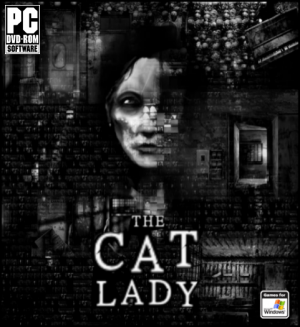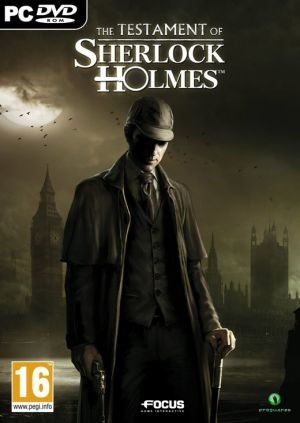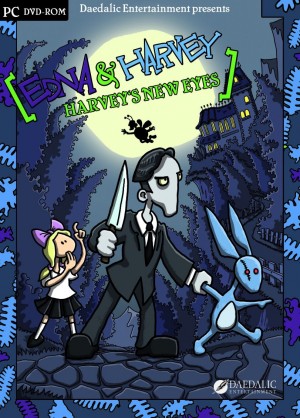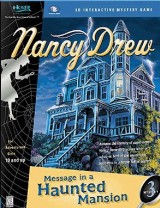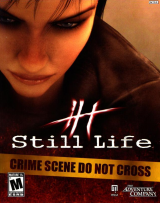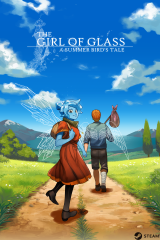Review for The Cat Lady
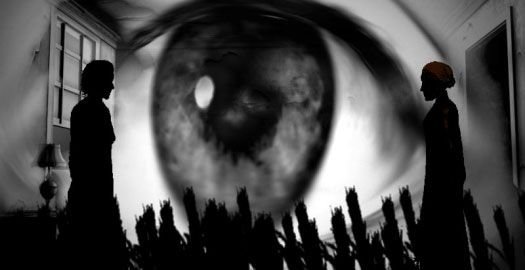
Game information
Adventure Gamers Awards
People call her the cat lady. Haggard and grim, Susan Ashworth is a cipher in her own life. Everyone thinks they know what she’s all about, but how can that be possible when even she doesn’t know? In a story that packs one emotional punch after the other, Harvester Games’ The Cat Lady melds story, gameplay, and atmosphere into a mental wrecking ball that will destroy your preconceptions about this woman and about how adventure games can provide insight into the deepest of human feelings. Its high level of gore will place it in the do-not-play column for some, but for everyone else even a few rough edges can easily be overlooked in this great piece of interactive storytelling.
Let’s get the gore out of the way first. This is an unapologetically adult game that deals with mature themes; in fact, the game opens with a blood red warning about the horrific scenes, sexual content, and violence that await within. Torture, cannibalism, attempted rape, mutilation; they’re all here in abundance. But the violence is certainly not the point of the game. Yes, gallons of virtual blood, viscera, melted faces, and more are splashed across the screen. And there are genuine scares and tension served up throughout the game. But that is really only the vehicle for telling the story of a woman literally and metaphysically fighting for her life. The emotional trauma that she suffers, and whether she eventually overcomes this with the help of a woman named Mitzi, is the real heart of the story.
Susan lives alone in her apartment. She does not have cats, but when she plays her piano the local felines are drawn to the music. She lives her life to the beat of a clock, shaped like a cat, its tail rhythmically beating out the seconds of her life. Always a failure in life, tonight she has failed even at suicide. Instead of dying, she wakes up and finds herself in a strange, surreal world, walking alone through fields of swaying wheat set against a cornflower blue sky.
In this side-scrolling third-person adventure, the controls are unusual but simple, using the left and right arrow keys to guide Susan in either direction. As you move, hotspots highlight when you pass over them, at which point you’ll use the up arrow to interact with them and can then scroll through a variety of actions (use, take, and other object-specific tasks). Once objects are added to your inventory menu at the bottom of the screen, the down button accesses it. In fact, you can play through the entire game just using the enter and arrow buttons on your keyboard with one hand. It took me a short time to get used to the controls, but once I did, I was able to move through the game without even thinking about it.
Inventory, dialogue, and logic puzzles are all well integrated into the story. Upon Susan's return from the world between life and death, she’ll need to escape a variety of scenarios, from hospitals to make-shift prisons and torture chambers. She’ll also need to break into rooms to gather information. Indie developer Rem Michalski blurs the line between reality and fantasy as the set-up for several ingenious puzzles that will have you complete actions in one reality to affect another. Even straightforward tasks become more difficult when Susan encounters them in a dream world where you don’t know what’s real and what isn’t. Opening a series of doors, for example, is no simple matter of going down the line until you find the one you need; you’ll need to investigate the clues around you to determine in which order to enter them.
You will never carry too many items at any time, and for the most part the inventory puzzles all make logical sense, whether you’re trying to flee from a suicide watch ward or scare the wits out of a bully. You’ll eventually get to use Mitzi to help you pick locks (a welcome change from having to search high and low for all manner of keys). Briefly adding an interesting twist is a pair of mental gauges, one of which pushes Susan over the edge into a mental breakdown if you have her do too many distressing things. The other you must fill by completing a series of tasks that soothe Susan enough for her to sleep. You’ll also get to play as a cat at one point, figuring out how to navigate several rooms as a feline would. Other characters may ask you to recite facts to make sure you were listening. As in real life, you can’t get away with just nodding and zoning out. This isn’t a chore, however, because the story and dialogue are so interesting.
It will take a while to get to know who Susan is and how she ended up downing a bottle full of sleeping pills. Starting in a fever-dream resulting from the coma she has fallen into, Susan wanders through fields and woods littered with burned out cars, pigs’ heads, and a mysterious crow. Nothing made sense to me in the opening chapter, but when I stopped and listened to the sounds around me, I eventually discovered what to do. As the imagery increasingly descends into madness (the carcass of a dead deer swarming with flies is particularly nasty), something awful happens in a smear of blood and you smack into the game’s opening credits and The Cat Lady officially begins.
The rest of the seven chapters have you following Susan on a nightmarish journey of self-discovery. Clearly she is depressed, but you will have to play through the entire story before learning why. During this mental exploration, Susan will meet characters that seem both real and fantastical: An old woman in the woods is called the Queen of Maggots by some. Is she death? Evil? This woman starts Susan on a journey to defeat five people she refers to as parasites. Murderers and deviants, they want to hurt or destroy Susan, so she must eliminate them as she would – in the Queen's words – remove weeds from a garden. Is it purely a matter of survival? Do you kill them to protect yourself or even to save others from harm? These are questions the game will pose as you navigate through dark moral waters.
Along the way, Susan will meet with a variety of memorable people, including a deranged couple with unusual tastes; the young woman, Mitzi, who breaks into Susan’s apartment only to save her life; a murderous suitor; and a friendly-seeming night nurse. A creepy psychiatrist with a slow and measured voice views his patients’ minds as art canvasses upon which he can practice his therapeutic arts. Who is real, and who are only figments of Susan’s mind, was not clear to me the first time through and may still not be clear after subsequent replays.
Nor could I tell whether Susan was a reliable narrator. She’s on drugs some of the time, many of which have hallucinatory side effects. Rather than drawing straight lines through seemingly allegorical characters and settings to literal meanings, I chose to give myself up to the waves of unreality the game crashes over you, letting myself be dragged under. Despite the variety of characters and symbolism (crucifixes, reflections, eyes, blindness) throughout the game, there are two main stories that you’ll be following: You’re discovering what happens to Susan as she tries to find and fight the five parasites, and looking for a man who was indirectly responsible for Mitzi’s boyfriend’s death.
The backdrop to these journeys is a jagged-edged, multi-layered aesthetic that revels in the use of color to set the mood. The designer’s color palette is one of death, blood, and miasma. Like a maestro of hues, Michalski uses colors to increase tension and then release it. Early on, Susan moves out of the burnt autumn colors of sienna, wine, and harvest yellow and into a black and white underground garage dominated by a blood red car. Color is used so well to evoke horror that I swear I breathed a sigh of relief when I saw a blue sky filled with white fluffy clouds.
Outside a few brief moments of respite, the game is stark and industrial with a film of surrealism clinging to everything, as if Trent Reznor fell asleep and dreamt of Dali. Everywhere you look, little details add another layer of interest and meaning. The old woman in the woods wears a black dress, but is it just how the light lays on the fabric, or does it conceal the outline of a skeleton? Elsewhere, lights – more of a glow really – slowly pulse in the background, echoing a heartbeat. Characters walk, lurch, or float through the air depending on their state of mind or madness. You will explore many diverse scenes, from woods haunted by evil to sterile hospitals to shipyards and apartment buildings.
These environments are stuffed full of horrific tableaus: An image of Susan crucified in a room with no back walls opening into a blue sky; a huge disembodied heart beating and spurting blood; a single gigantic eye jerking around; two huge bloody dolls with wedge-shaped white heads following your every move. There is also quite a bit of nudity in the game, which only further highlights the vulnerability of life’s victims. But it’s here that the developer tries a little too hard to horrify the player. One character’s madness is already well-established, and when you think you’ve moved on, an image of the man torturing a naked victim is an unnecessary punctuation point.
But amidst the horror, there is also great beauty, though not the traditional beauty of gorgeously rendered artwork. The design here is almost crude, with quivering line-drawings for much of the character models. This is the allure of a crumbling wooden house, sitting lonely on a windswept plain. A rushing river holds the promise of death, but it is also captivating, rushing darkly beneath a golden sunset. Scenes of wind whispering through a field of waving wheat and the serenity of an empty blue sky break through the morbidity like spears of sunlight through dark clouds; reminders of the beauty that can still be found in sadness.
The animations also convey quite a few scares. The sudden appearance of a menacing shadow; the moment when a woman facing away from you suddenly turns; a ceiling lamp swinging in a half-lit room that no one had been in before; these images made my heart jump into my throat. There are also some truly clever uses of animation. In one scene, Susan is discussing the previous night’s experience with her doctor. An image of the scene appears above both their heads. Push your movement arrow and the characters in the scene-within-the-scene begin to move – fantastic!
Even if you were to close your eyes, the script echoes the game’s dichotomous beauty and brutality. “You will become my hunter. A dark angel through a dark river of blood,” says the old woman. This is not a game that shies away from life’s unpleasantness. Like a David Mamet screenplay, characters unleash their rage, hopelessness, and madness (“your scream is like a poem without words”) in profanity-laden dialogue. But there is a point to this. These are characters fighting for their lives, both physically and mentally. Despite the surreal nature of the game, the realism of the dialogue is spot on. The developer absolutely nails emotional trauma, whether it’s a character discussing her partner’s reaction to a cancer diagnosis or the painful ways in which we dig at and hurt each other when we argue with the ones we love.
As you talk with others, there are many points where you can choose a certain line of action. Early choices don’t lead you down an entirely different track that I could see, but you are responsible for what the game reveals about Susan’s past, and this may influence other decisions you make as the game progresses. You can also choose whether to be helpful, apologetic, insulting, or sarcastic, which may determine how that character will treat you later. It isn’t always easy to determine the consequences of your choices, which is a point one of the characters makes (and not unlike the choices we make in real life). One annoyance with these conversations, however, comes after you’ve completed a dialogue tree. Many times the exhausted choices will disappear, but sometimes they don’t, suggesting you could gain more info by clicking them again. But no, you have to restart the same topic and sit through it all again. And while you can click through the dialogue, some of the exchanges can be quite long.
Sound is of the utmost importance in a horror game, and it doesn’t disappoint here. In one scene, an empty ambulance blocks Susan’s way. As you walk away, you hear a clanging sound. It can’t be coming from the ambulance, can it? As you move back toward it, the clanging gets louder, more insistent. My nerves were jangling by the time I attempted to open what I thought was an empty vehicle. One of the more effective uses of sound occurs in the dark. Once as I navigated Susan through near total darkness, I could hear a rhythmic squelching. My stomach turned in increasing horror that only increased when I finally viewed the huge slug-like thing bucking on a table that was making the noise. After a character jumps from a building, you hear a bone-shattering crash, the barking of a dog, and the wailing of a car alarm; a sad and lonely chorus for the end of a life. And I don’t know how many sounds there are of blood splattering, but I’m sure I heard every single variation in this game.
The soundtrack is moody and at times angry, with original songs written for the game. There are moments where the tension is ratcheted just a bit higher with musical distortion, drums, and bass. These are supremely effective in setting the scenes, with lines from songs echoing what is going on in the scene (“Don’t worry love, it’s only the end of the world”). However, there are times when silence would have served better than background music, particularly the quiet moments between characters where the dialogue should shine alone.
The voice acting is tremendous, which is crucial because there is so much of it during the game’s nearly nine-hour playing time. Susan was a bit off-putting to me at first; affectless and dry. But this only served as a baseline from which the actress managed to build in a subtle but ever-increasing sense of character development. The gravelly-voiced Mitzi presents a combination of world weariness and energy in the face of tragedy at the same time. A pesticide guy with a penchant for rape is beyond horrifying, his slow voice punctuated by heavy breathing.
After a heart-pounding beginning and gut-wrenching middle, the game becomes a whodunit and the action begins to slow down. But this isn’t a bad thing, as the baptism through blood and horror leaves Susan open to reaching out and connecting with her fellow human beings again. She finally begins to learn about the lives of her neighbors, those previously anonymous souls who only served to annoy or ignore her. When Susan and Mitzi finally come face to face with their nemesis, even that is presented with complexity and depth, challenging you to understand why this character would have done what s/he did. You’re given a choice at the end to determine this answer, and I don’t know if I made the right one or just the easy one; regardless, the ending meant something to both the characters and to me.
It wasn't the horrific scenes (say, of a bloody nurse hacking away at raw lumps of meat) that left their deepest impressions on me. It was the more subtle ones. A young woman, vibrant and full of life, is about to tell Susan why she can trust her. Before she can, a vision of a desiccated crone appears behind the young woman, bending forward to softly kiss her ear. And you know – as does Susan – that tragedy will ultimately befall this character. Don’t get me wrong; the gore serves its purpose. It wrecked me and left mre, made me raw and quivering just as Susan must have felt. It also heightens the sense of relief you feel when you get a short break from the insanity while Susan has a smoke and a cup of coffee listening to the rain pour outside her apartment, or when two characters play a game of guess-what-I’m-thinking. It feels good to do these normal things, to start to live your life again, however temporary you know they will be.
But despite all the trappings of death and madness, The Cat Lady (available from Screen7) is ultimately the story of one woman who wants to die but must go on living and another woman who wants to live even in the shadow of tragedy. Death in the midst of life, and life in the midst of death. There are so many more things I could write about what the game means, but the experience may touch you in a totally different way, and that is the beauty of it. At times it seems an embarrassment of riches, and a bit more focus, a bit less gore would have earned this game my highest possible praise. Given the game’s grisly subject matter and unflinching brutality, I can’t recommend it to everyone, but the emotional issues explored here are more raw and real than any I’ve ever encountered in a game. I defy you to play it and not be moved. But do play it. Delve into the darkness and see what it means for you.


